12-5. The 7th kiore had lost
(or was destined to loose)
his footing:
|
1 |
 |
7 |
 |
13 |
 |
19 |
 |
|
2 |
 |
8 |
 |
14 |
 |
20 |
 |
|
3 |
 |
9 |
 |
15 |
 |
21 |
 |
| 4 |
 |
10 |
 |
16 |
 |
22 |
 |
|
5 |
 |
11 |
 |
17 |
 |
23 |
 |
|
6 |
 |
12 |
 |
18 |
 |
24 |
 |
And his glyph number (420 → 7 * 60
and 6 * 70) suggests
414 + 6 ('sleeping mats'). Furthermore, 414 - 16 = 398 could
allude to the synodic cycle of Jupiter (Jus
Piter, the Father of Light).
|
Synodic
cycles: |
|
Mercury |
115.88 →
116 = 4 * 29 |
|
Venus |
583.92 → 584 = 3 * 116 + 8 * 29½ |
|
Earth |
π * 116 →
364.24 |
|
Mars |
779.96 → 780 = 584 + 4 * 49 |
|
JUS PITER

398.88
(→
584 -
186)
 |
|
Saturn |
378.09 → Phoenix |
|
Uranus |
369.66 → 370 = 584 -
214 |
|
Dec 27 |
28 |
29 |
30 (364) |
 |
 |
 |
 |
|
Eb3-13 |
Eb3-14 |
Eb3-15 |
Eb3-16 (85) |
|
kua tua te vaivai |
rima |
kua tuo te tino |
te
rima - te kihikihi |
|
Vaivai,
weak. PS Mq.: vaivai,
soft, pleasant, agreeable. Sa., To.:
vaivai, weak. Pau.:
Hakavaivai, to delay. Ta.:
vaivai, to rest a bit. Mq.: vaivai, to dilute,
to thin. Ha.: waliwali, soft, pasty. Churchill.
Tuo.
Mgv.: tuo, to speak long without an answer. Ta.: tuo,
to cry out loudly. Ha.: kuo, to cry with a loud voice.
Churchill.
Tino. 1.
Belly (as reported by a Spaniard in 1770). 2. Genitalia (modern
usage). 3. Trunk (of a tree), keel (of a boat); tino maîka,
banana trunk; tino vaka, keel. Vanaga. Body, matter; mea
tino, material; tino kore, incorporeal. P Pau.: tino,
a matter, a subject. Mgv.: tino, the body, trunk. Mq.:
tino, nino, the body. Ta.: tino, id. Churchill. |
|
No
star listed (98) |
Aurigae (99.4), ψ2 Aurigae (99.5)
GEMMA (α
Cor. Bor.) |
ψ4
Aurigae (100.5),
MEBSUTA (Outstretched) = ε Gemini
(100.7) |
SIRIUS = α Canis
Majoris
(101.2), ψ5 Aurigae
(101.4), ν Gemini (101.6), ψ6 Aurigae (101.7)
*60.0 = *101.4 - *41.4 |
|
... In other words, the ancient
Druidic religion based on the oak-cult will be swept away by
Christianity and the door - the god Llyr
- will languish forgotten in the Castle of Arianrhod, the Corona
Borealis. This helps us to understand the relationship at Rome
of Janus and the White Goddess Cardea who is ... the Goddess of
Hinges who came to Rome from Alba Longa. She was the hinge on which
the year swung - the ancient Latin, not the Etruscan year - and her
importance as such is recorded in the Latin adjective cardinalis
- as we say in English 'of cardinal importance - which was also
applied to the four main winds; for winds were considered as under
the sole direction of the Great Goddess until Classical times
...
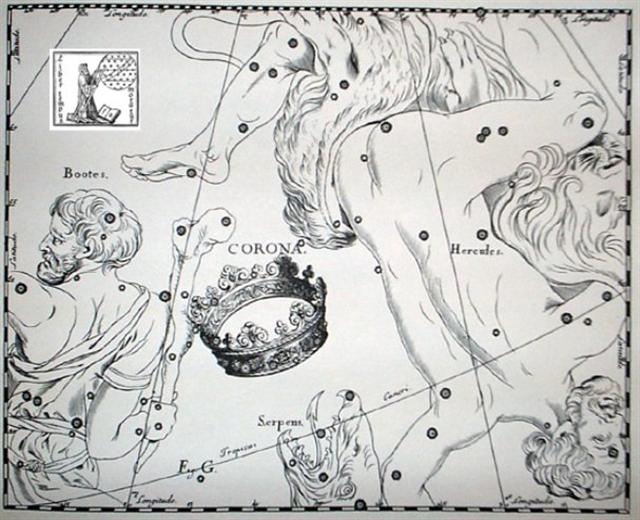 |
|
June 27 |
28 |
29 |
30
(181) |
 |
 |
 |
|
Eb3-17 |
Eb3-18 (14 * 29½ = 413) |
Eb3-19 (88, 414) |
|
kua moe - kua reva te ika |
tama - reva ika |
kiore - henua |
|
Reva.
To hang down; flag, banner. Revareva,
1. To be hanging vertically; to detach oneself from
the background of the landscape, such a person
standing on top of a hill: ku-revareva-á te
tagata i ruga i te maúga. 2. To cast itself, to
project itself (of shadows); revareva-á te kohu o
te miro i te maeha o te mahina, the shadow of
the tree casts itself in the light of the moon. 3.
Uvula. Vanaga. To hang, to suspend, flag, banner;
hakareva, to hang up; hakarereva, to hang
up, to balance; hakarevareva, to wave. T
Pau.: reva, a flag; fakarevareva, to
hang up, to suspend. Mgv.: reva, a flag, a
signal. Mq.: éva, to hang up, to be
suspended, to wave a signal. Ta.: reva, a
flag, banner; revareva, to wave. The germ
sense is that of being suspended ... any light
object hung up in the island air under the steady
tradewind will flutter; therefore the specification
involved in the wave sense is no more than normal
observation. Churchill. Mgv.: 1. A plant. Ta.:
reva, id. Mq.: eva, id. Sa.: leva,
id. Ma.: rewa-rewa, id. 2. To cross, to pass
across quickly; revaga, departure. Ta.:
reva, to go away, to depart. Ma.: reva,
to get under way. Churchill. Ta.: The firmanent,
atmosphere. Ha.: lewa, the upper regions of
the air, atmosphere, the visible heavens. Churchill. |
|
VISIBLE CLOSE TO THE FULL MOON: |
|
July 1 (118 + 64) |
ALHENA (γ Gemini) |
3 (184 → 414 -
230) |
|
APRIL 28 (118
→ 4 * 29½) |
29 |
30 |
 |
|
INVISIBLY CLOSE
TO THE SUN: |
|
Dec
31 (*285) |
Jan
1 (366 = 2 * 183) |
2 |
|
SHELIAK (Tortoise) =
β
Lyrae,
ν
Lyrae (285.1),
ο
Draconis (285.5).
λ
Pavonis (285.7)
ATLAS (27 Tauri) |
χ
Oct. (286.0),
AIN AL RAMI (Eye of the Archer) =
ν
Sagittarii
(286.2),
υ
Draconis (286.4),
δ
Lyrae (286.3),
κ
Pavonis (286.5),
ALYA (Fat Tail) =
θ
Serpentis
(286.6)
*245.0 = *286.4 - *41.4 |
ξ
Sagittarii (287.1),
ω
Pavonis (287.3),
ε
Aquilae,
ε
Cor. Austr.,
SULAPHAT (Little Tortoise Shell) =
γ
Lyrae (287.4),
λ
Lyrae (287.7),
ASCELLA (Armpit) =
ζ
Sagittarii,
BERED = i Aquilae (Ant.)
(287.9)
*246.0 = *287.4 - *41.4 |
 |
 |
 |
 |
 |
 |
|
Eb3-20 |
Eb3-21 |
Eb3-22 (91) |
Eb3-23 |
Eb3-24 |
Eb3-25 (420) |
|
Rei tu |
tu
te niu - e huki |
kua noho i te niu -
kotia |
ku hakarava |
te hatu |
kiore - henua |
|
Hatu. 1. Clod of
earth; cultivated land; arable land (oone
hatu). 2. Compact mass of other
substances: hatu matá, piece of
obsidian. 3. Figuratively: manava
hatu, said of persons who, in
adversity, stay composed and in control
of their behaviour and feelings. 4. To
advise, to command. He hatu i te
vanaga rivariva ki te kio o poki ki ruga
ki te opata, they gave the refugees
the good advice not to climb the
precipice; he hatu i te vanaga
rakerake, to give bad advice. 5. To
collude, to unite for a purpose, to
concur. Mo hatu o te tia o te nua,
to agree on the price of a nua
cape. 6. Result, favourable outcome of
an enterprise. He ká i te umu mo te
hatu o te aga, to light the earth
oven for the successful outcome of an
enterprise. Vanaga. 1. Haatu,
hahatu, mahatu. To fold, to
double, to plait, to braid; noho hatu,
to sit crosslegged; hoe hatu,
clasp knife; hatuhatu, to deform.
2. To recommend. Churchill. In the
Polynesian dialects proper, we find
Patu and Patu-patu, 'stone',
in New Zealand; Fatu in Tahiti
and Marquesas signifying 'Lord',
'Master', also 'Stone'; Haku in
the Hawaiian means 'Lord', 'Master',
while with the intensitive prefix Po
it becomes Pohaku, 'a stone'.
Fornander. |
|
VISIBLE CLOSE TO THE FULL MOON: |
|
July 4 |
5
(186) |
6 (*107) |
7 |
8 |
9 (*110) |
|
MAY 1 (11
* 11) |
2 |
3 |
4 |
5 |
6 (*66) |
|
ω
Gemini (105.4), ALZIRR (Button) =
ξ
Gemini
(105.7),
MULIPHEIN
(Oaths) =
γ
Canis Majoris
(105.8),
MEKBUDA (Contracted) =
ζ
Gemini
(105.9)
*64.0 = *105.4 - *41.4 |
7h
(106.5)
No star listed (106) |
WEZEN (Weight) =
δ
Canis Majoris
(107.1),
τ
Gemini (107.7),
δ
Monocerotis (107.9) |
No star listed (108) |
λ Gemini (109.4),
WASAT (Middle) = δ Gemini (109.8)
*68.0 = *109.4 - *41.4 |
No star listed (110) |
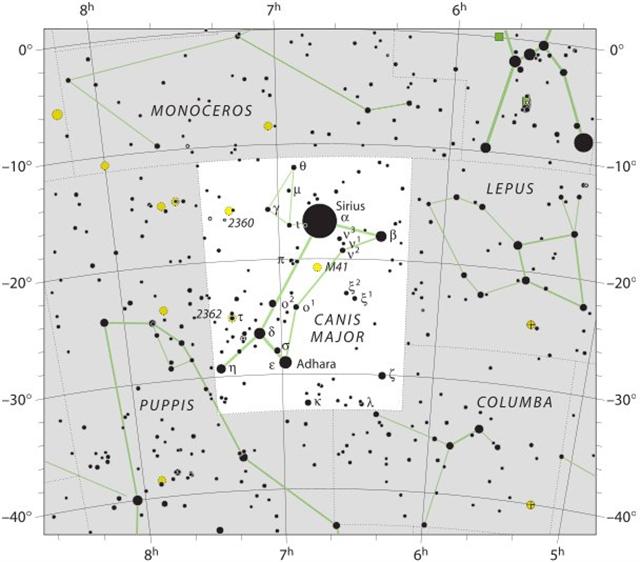
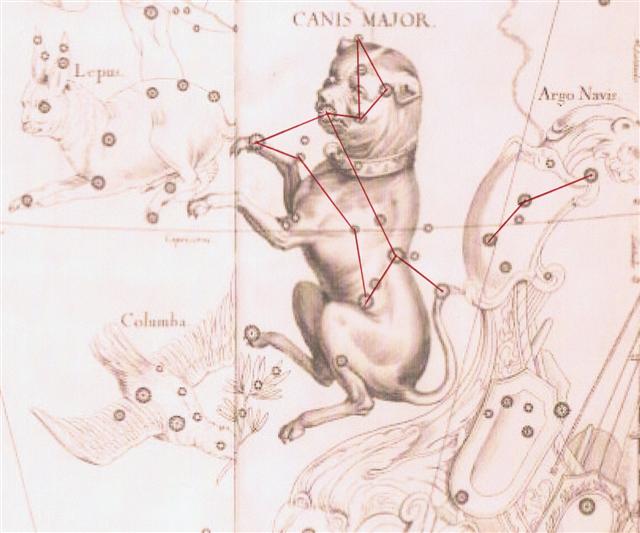 |
|
INVISIBLY CLOSE
TO THE SUN: |
|
Jan 3 |
4 (369) |
5 (*290) |
6 |
7 |
8 |
|
Al Na'ām-18 (Ostriches)
/
Uttara Ashadha-21 (Elephant tusk, small bed)
NUNKI = σ Sagittarii
(288.4),
ζ Cor. Austr. (288.5),
MANUBRIUM = ο Sagittarii
(288.8), ζ Aquilae (288.9)
*247.0 = *288.4 - *41.4 |
19h (289.2)
λ
Aquilae (Ant.) (289.1),
γ
Cor. Austr (289.3),
τ
Sagittarii (289.4),
ι
Lyrae (289.5),
δ
Cor.
Austr. (289.8)
*248.0 = *289.4 - *41.4 |
Al
Baldah-19 (City)
AL BALDAH = π Sagittarii, ALPHEKKA (Dish)
MERIDIANA = α Cor. Austr.
(290.1), β Cor. Austr. (290.2) |
ALADFAR (The Talons) = η Lyrae
(291.1),
NODUS
II = δ Draconis
(291.5), ψ Sagittarii (291.6), τ Draconis
(291.7), θ Lyrae (291.8) |
ω Aquilae (292.1), ρ Sagittarii (292.6), υ
Sagittarii (292.7) |
π Draconis,
ARKAB PRIOR = β¹ Sagittarii
(293.0),
ARKAB POSTERIOR = β² Sagittarii,
ALRAMI (The Archer) = α Sagittarii
(293.2), χ Sagittarii (293.6 |
Hevelius has indicated how the right foot of the
Archer, Al-rami (α
Sagittarii), became lost:

Or at least rather how it was uplifted
- like the adjacent Milky Way River:

... The
Raised-up-Sky was
a region close to Aquila, which seems reasonable because
according to the Babylonians the Milky Way was upraised
from the place of the Cargo Boat (the Tea Pot,
the South Dipper) beyond which the Eagle & Dead Man
were following the Milky Way across the sky ...
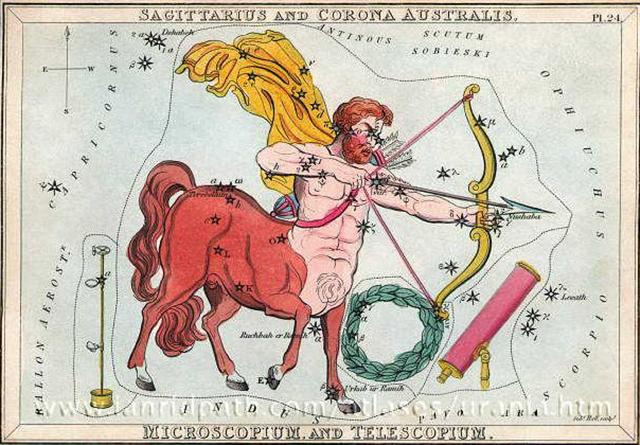
... About Carmenta we know from the historian Dionysus
Periergetis that she gave orcales to Hercules and lived
to the age of 110 years. 110 was a canonical number, the
ideal age which every Egyptian wished to reach and the
age at which, for example, the patriarch Joseph died.
The 110 years were made up of twenty-two Etruscan
lustra of five years each; and 110 years composed
the 'cycle' taken over from the Etruscans by the Romans
...
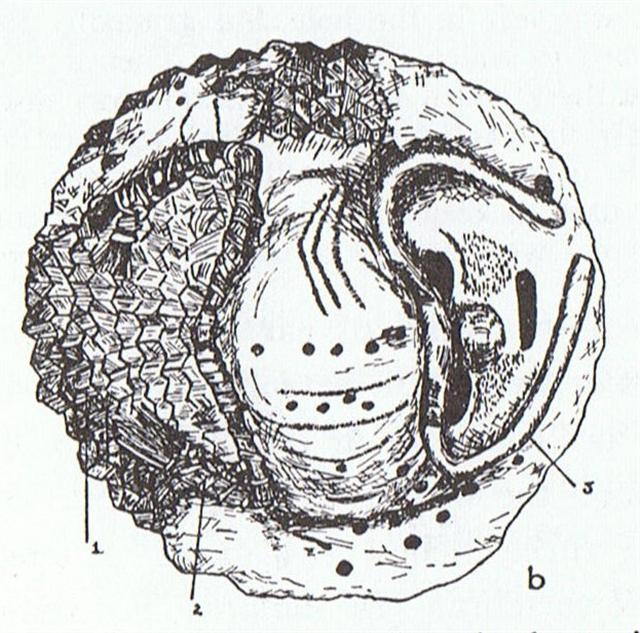

.jpg)
|
























.jpg)